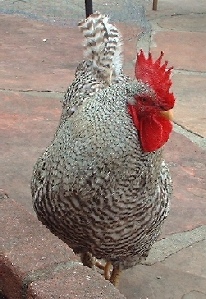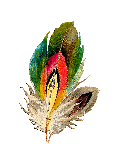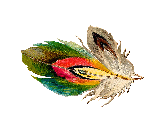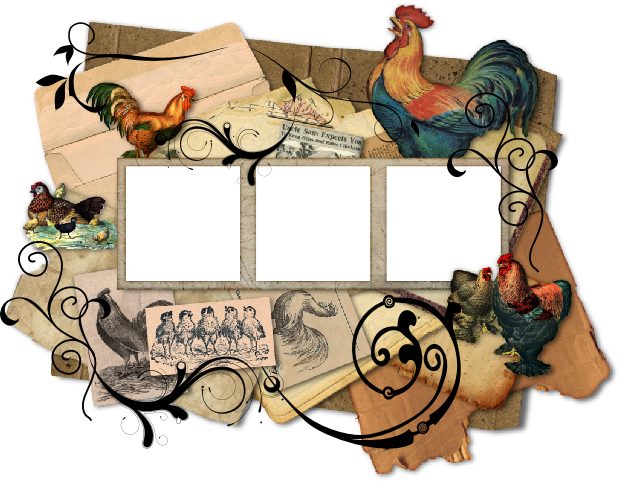
Short answer: yes, ick.
I'm not an expert or a vet, but this is what works for me. I've been doing it this
way for years with no ill effects. Poultry are subject to an amazing number of parasites
and illnesses. Gapeworm, roundworms, mites, etc. are parasites carried in by wild
birds and can live in the soil, earthworms, beetles, etc. of your yard, that's why
you need to routinely treat your birds-
GameRooster.com has a great page on parasites, which meds kill which worms:
URL: http://www.gamerooster.com/disease/parasites.html
Gapeworms are really roundworms which infest the trachea of the bird. If you worm
your birds every six months with a good all-
Here's info on Gapeworm and what a Gapeworm looks like, if you really want to see one:
URL: http://cal.vet.upenn.edu/projects/merial/Strongls/strong_4.htm
You can pick up paste wormer for horses at most feed stores or online. I buy it ahead
of time on Ebay or at online animal medical supply houses such as Valley Vet Supply
for about a half to one third of what the feed store charges! It's easy to do and
can be done by one person if you have tame birds, otherwise it takes two people.
All you do is put a small BB size amount in a small bottle and shake to mix with
about 1 ounce of water. It will be hard to mix but keep at it. Give each bird 4-
Worming & Dusting/Spraying
What What WHAAAT?! Chickens Can Get WORMS?!

Velvet Sparrow
**IMPORTANT**
You MUST repeat this in 2 weeks to break the worm's life cycle and kill any hatching worms, after that just do it once every six months. If you do not give your birds the second round of wormer, the hatching worms will simply reinfest your birds right away, and you've wasted time, money and good medicine by not following through correctly. Also the worms will have built up that much more of a resistance to the wormer, and the medicine is hard on your birds' internal organs. Use wormer conscientiously and correctly.
If you suspect illness, please read the ENTIRE ‘Health’ section on my site–I go into much more detail. If you think your chicken needs a vet, CALL ONE! Info on this site is NOT meant to take the place of proper veterinary care, and I assume no responsibility for your use of the information on this site.
Again, remember: Do not eat your hens' eggs for at least two weeks after using a chemical wormer, as it can be passed along in the eggs.
The Chicken Checklist And How To Hold A Squirming Chicken
We have a printed list of our chicken's names. We use it all the time when worming or otherwise needing to do any kind of mass chicken annoying. It's especially handy for hens that are nearly identical, we'll catch and dose first one of the lookalikes, than immediately do the other to avoid confusion. The list is invaluable for making sure to avoid double dosing or missing someone, You simply check their name off the list as you treat them.
As for holding chickens to medicate them and prying open beaks-
Doing it by yourself would be much the same, only you can hold the bird in your lap with their butt against your belly/left side and your left arm over and around their body to trap/brace them, or you can wrap them in a towel so they can't struggle and flap. You can also sit on the ground, legs under you (basically kneel down and sit on your legs), your feet crossed at the ankles if need be. The chicken goes between your knees, which brace it, head pointed out. Grab their head as above.
The real key to this is being gentle but firm and fast. Don't be wishy-
With either method, at the end give them pets, profuse apologies and treats. This reduces but will completely eliminate the Stink Eye they will give you.
Diatomaceous Earth (DE)
I use a broad spectrum, commercial paste wormer and have no experience using anything
else, but some people swear by food grade (only!) Diatomaceous Earth (DE). Diatomaceous
earth is made from the remains of fossilized marine algae called diatoms. The product
is mined and reduced to silica powder form. When eaten, this powder acts as tiny
pieces of glass that tear the shells of insects and other arthropods. Insects die
within one to two days from dehydration. Here's the catch though, and it's a big
one-
So for what it's worth, here's how one person I know uses it and this is his experience talking here, not mine:
"While wearing a dust mask to protect your lungs (DE is dangerous to breathe)
mix food grade or agricultural grade Diatomaceous Earth into the chicken feed. Use
one (1) tablespoon of Diatomaceous Earth for each gallon of dried feed, (i.e. chicken
scratch, feed grains, etc.). Also sprinkle it in the pens. The chickens are dewormed,
don't get mites, and there's no flies nor smell in the pens. The DE will also kill
any insects the chickens don't eat. I also feed it to my large livestock for deworming.
DE doesn't kill with poison; it slits the outer skin of the insect and dehydrates
them. 'FILTER grade' DE that goes into your swimming pool will NOT kill worms, but
WILL KILL your livestock. DO NOT USE 'filter grade' DE on anything living. Only
food grade! With DE there is no need to avoid eating the hen's eggs for a week or
two, and the parasites cannot develop an immunity to DE since it works mechanically,
not chemically, to kill the worm. I've read that since DE only works when dry, it
is not an effective wormer-
So you see the problem with DE-
Mites
Mites are tiny, crawling external parasites that are VERY opportunistic little buggers,
they can infest your birds, the coop, nest boxes–basically wherever the chickens
live. Usually birds can handle these ubiquitous pests by daily preening and dust
baths, but when a bird falls ill and doesn't preen and care for itself as it normally
does, even for just a few days, the population of mites can EXPLODE and pose a serious
threat to the already compromised health of sick or injured birds. If your bird is
sick or injured with ANY other problem, keep checking them for mites! Mites can and
will weaken your bird to the point of killing them if left untreated. Excessive preening
and/or 'fear of the coop'-
You can check your bird for external mites by placing the suspected bird on a white
surface such as some white paper towels for about 20 minutes or so. Mites are attracted
to the color white and will migrate from the infested bird to the white paper towels.
You can also check your birds feathers, especially on their heads & necks, on feathered
feet, under wings and the mites favorite hangout, around the vent and under the tail
on your chicken's fluffy fanny feathers. On crested breeds such as Silkies and Polish,
their head poofs are also favorite mite infestation spots, as well as a Cochin's
fluffy feathered legs. Heavy breeds with big fluffy butts can be more prone to vent
area mite infestations. Mites prefer the fluffy feathers and will collect and cling
to them, causing what looks to be a thick, grayish dust clinging to the feathers–the
grayish dust is mites, mite eggs and mite debris. If you see tiny, crawling reddish-
Although paste wormers will also take care of mites from the inside out, because
a wild bird can infest your birds at any time I also dust my birds for external mites
with powdered Sevin (made by Ortho) or Adams Flea & Tick Mist every six weeks or
so. With my birds I prefer the Adams spray, it is FAR less messy, easier to apply
and target to affected areas and is less likely to wash off if the bird gets wet.
But I will give the application method for both Sevin and the Adams spray here-
If it rains and things get and stay wet and muddy (washing away that Sevin you just applied), you may find the mite problem to be more stubborn, especially on cochins or feather footed and/or crested birds. You just grab a handful of Sevin dust and rub it all over the chicken, especially under their heads, wings and underbellies, massaging it down to the skin. Really rub it in, get enthusiastic–it needs to be down next to the skin. Same with the Adams spray, part the feathers and spray it on the base of the feathers as well as you can, then use your fingers to work it in and distribute it. Go after their undercarriage and vent area especially, where mites love to hang out. Naturally chickens do not appreciate such intimate handling (especially the cold, wet spray) and will complain and resist.
When I spray/dust my birds I also dust their coop, roosts and nests since mites dwell there and you need to kill ALL the mites. Sevin and the Adams spray are a poison and should be used with the proper care and precautions (especially around children, banish them to the safety of the house) including gloves, a dust mask, eye protection, long sleeves and long pants. Be smart when it comes to using insecticides! Use them when needed but apply them properly, in the correct amounts (too little and you'll be doing it again) and safely. You'll want to shower and shampoo very well afterwards. It does not seem to hurt the birds if it accidentally gets in their eyes or mouths (But be careful around their heads, usually only crested breeds need any mite treatment on their heads) and can be used on birds as young as 2 months. The Sevin dust sticks around for several days so watch out for it. If it rains or your birds get wet, reapply the Sevin (the Adams spray isn’t affected by moisture as far as I know). I don't think the Sevin affects the eggs a hen will lay but you may want to not eat your hens' eggs for two weeks after dusting to be safe. Mites CAN develop an immunity to Sevin after a while, so it's a good idea to use Sevin for several cycles, then switch to something else, such as Adams Plus Flea & Tick Mist (with the ‘Plus’ the protection lasts and kills hatching mites). The Adams spray you simply spray on and work down into the feathers and skin, avoiding their eyes and mouth. Adams also makes a flea/tick shampoo that is very useful for heavily infested birds.
I spray or dust and worm my birds at the same time just to get it over and done with,
plus it's easier to remember when it was done that way. My birds suffer no ill effects
from having both medications applied. At the same time it's a good idea to first
check everyone's beak, comb, feet, etc. for a general health inspection before spraying
them-
Scaly Leg Mites
Another charming external parasite, this time they like to burrow under the scales
of your chicken’s legs and feet causing a swollen, raised or bumpy looks to the scales.
Once the scales are raised, they stay that way even if you eradicate the mites.
With swollen legs or feet on a chicken, check your birds for Scaly Leg mites. Check
your other birds' feet and legs for similar symptoms. Scaly leg mites are easily
solved, you can spray the legs REALLY well (make sure you get up under the scales,
hold the bird in such a way that the liquid runs up under the scales) with Adams
Flea & Tick Mist to kill them. Or you can buy a really stinky liquid to paint on
their legs at your local bird pet store, again making sure to rub it up under the
scales (warning-
You can see why I prefer the Adams spray. Much faster, neater and causes less chicken-
Prevention–Keeping It From Happening In The First Place
The VERY best thing you can do for your birds is provide day to day excellent living conditions–lots of room to free range, a clean living area, fresh water & food and access to fresh greens and other goodies daily. Having your flock in the very best health you can goes a LONG way towards heading off any problems in the first place.
Healthy birds can better fend off minor problems, and birds that have had a chance to build up an immunity to common illnesses are stronger, better flock members and have a better chance of fighting off illnesses. Do not allow things like mold, standing water and debri around your chickens, and try to keep wild animals, vermin and birds away from your chickens and their food & water–these backyard visitors are disease vectors.
See the ‘Coop & Run’ section of this site for how to treat the coop using a pesticide-

Enjoying the chickens? Has my site helped you?
Want to buy the chickens some goodies?
Click the button!



 >
>








